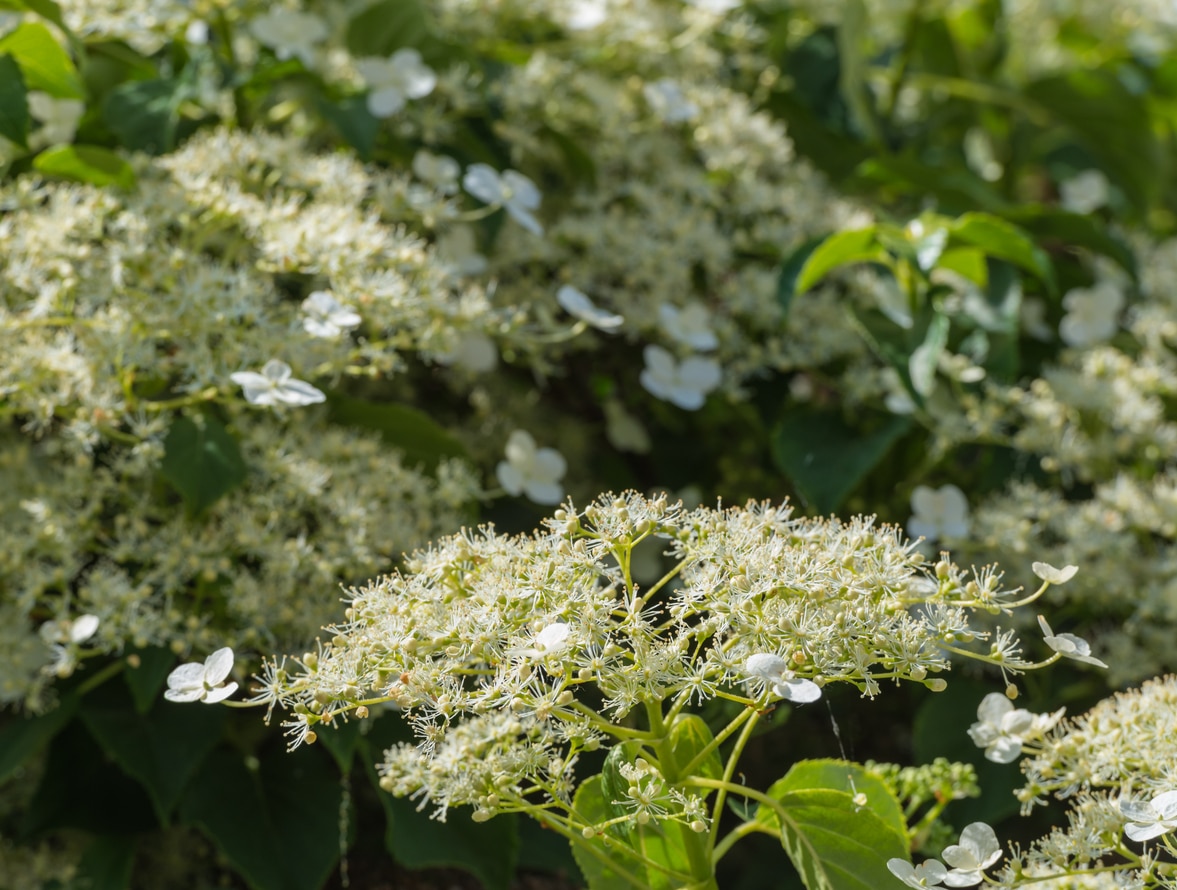Hydrangea Care
General Siting and Environmental Guidelines
Hydrangeas like a rich, moist soil. While not tolerant of living in water, Hydrangeas are big drinkers. On hot days, their large leaves and fleshy stems can call for water faster than their systems can deliver it. Site Hydrangeas where they’ll get irrigation. Mulching is recommended to help contain moisture (and protect roots in winter). The planting site should get at least some morning sun. Although some cultivars of Hydrangea will do in all day sun, most benefit from a touch of afternoon shade in that the plants are stressed less during the most intense heat/light period of the day. Hydrangeas do not bloom well in total or deep shade.

Hydrangea Macrophylla
Macrophyllas are the most popular hydrangeas, with blooms in mophead and lacecap forms. They usually flower from last year’s wood, so prune only when necessary to avoid reducing blooms. Prune dead branches in spring once it’s clear they won’t sprout, and then leave the plant alone. Some varieties, like ‘Endless Summer’ and ‘Dooley,’ bloom on both old and new wood and tolerate more pruning. Cutting stems for drying or arrangements won’t harm the plant unless overdone, and feel free to remove old, unsightly blooms.
Hydrangea Paniculata
Panicle Hydrangeas have pointed dome-shaped blooms in white or cream. Unlike macrophyllas, they tolerate full-day sun or partial shade. These hydrangeas grow quickly, often 2-6 feet in a season with optimum nutrition, and bloom on new wood, making severe pruning possible. However, avoid summer pruning, as it disrupts stem maturity and flower bud initiation. The best time to prune is in winter or early spring when you can cut back by up to three-quarters and then leave the plants to grow.


Hydrangea Quercifolia
Oakleaf Hydrangeas are named for their oak-like leaves. They thrive in near full sun or light shade and have a similar growth habit to panicle types, with pointed white to greenish blooms. These hydrangeas grow slowly, especially when young, making them more expensive. They are also valued for their fall foliage, turning deep burgundy. Since they bloom only on old wood, it’s best to leave them untrimmed. If pruning is necessary, remove entire stems in late winter to preserve bloom potential.
Hydrangea Aborescens
Smooth Hydrangeas are typically broad, mounded shrubs with smooth, light green leaves. They appreciate morning sun and afternoon shade. Most bloom white, either in a mushroom cap look or a lacy effect. Flowers arrive on new wood. Similar to the panicle types, they can and should be shaped in winter or pre-spring, then left alone.


Hydrangea Anomala
Climbing Hydrangeas are slow-growing, woody vines that cling to structures via air roots. They do their best near full sun and a considerable amount of shade. They bloom old wood with wide, flat, lacecap-type flowers. While pruning will eliminate flowering, mature plants are many-stemmed so some shape-correction or runner-control won’t bring disastrous results. Pruning is best done in the winter. The Schizophragmas, close cousins to Hydrangeas, are similar vining types. They are handled the same as Hydrangea Anomala.
Hydrangea Serrata
The Mountain Hydrangea is closely related to the macrophylla for which they’re often mistaken. The difference between the two is that Mountain Hydrangeas are somewhat more drought-tolerant. Slight shade works best. Like the macrophyllas, they bloom both in mophead and lacecap forms. Most bloom on old wood. Cut off dead branches or branch portions in mid-spring when it becomes obvious what
won’t sprout, then let them be to do their thing.

Hydrangeas that bloom white cannot change color, but those with pink, purple, or blue flowers can. Color change in macrophylla and serrata types depends on soil pH.
What is pH?
pH measures soil acidity or alkalinity on a scale from 0 to 14, with 7 being neutral. Below 7 is acidic, and above 7 is alkaline. pH affects element availability in soil, which in turn affects hydrangea color.
Elements & Hydrangeas
Key soil elements include nitrogen, potassium, phosphorus, iron, aluminum, and more. Hydrangea color is influenced by aluminum ions, which turn flowers blue at acidic pH (4.5-5.5). Higher pH (6.0-6.5) promotes pink tones.
Increasing Acidity for Blue Flowers
For new beds, mix 1-2 pounds of aluminum sulfate per plant. For established beds, apply aluminum sulfate in November and March. Adjust rates based on soil type.
Increasing Alkalinity for Pink Flowers
For new beds, mix 1 pound of ground limestone per plant. For established beds, apply limestone in November and March. Add iron if chlorosis occurs.
Timing & Testing
Changes take time, often months. Test soil pH with home kits, aiming for 4.5-5.5 for blue tones and 6.0-6.5 for pink tones.
Safety Note
All compounds mentioned are intended for soil feeding, not foliar feeding, so always awash leaves following application. Avoid using aluminum near edible plants.

